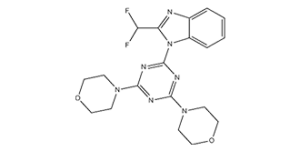ZSTK474
This product is for research use only, not for human use. We do not sell to patients.

For small sizes, please check our retail website as below: www.invivochem.com
| Size | Price | Stock |
|---|---|---|
| 1g | $390 | Check With Us |
| 2g | $590 | Check With Us |
| 5g | $995 | Check With Us |
Cat #: V0113 CAS #: 475110-96-4 Purity ≥ 98%
Description: ZSTK474 is a novel, potent and ATP-competitive pan-PI3K inhibitor (class I) with potential anticancer activity.
Top Publications Citing Invivochem Products
Publications Citing InvivoChem Products
Product Promise

- Physicochemical and Storage Information
- Protocol
- Related Biological Data
- Stock Solution Preparation
- Quality Control Documentation
| Molecular Weight (MW) | 417.41 |
|---|---|
| Molecular Formula | C19H21F2N7O2 |
| CAS No. | 475110-96-4 |
| SMILES Code | FC(C1=NC2=CC=CC=C2N1C3=NC(N4CCOCC4)=NC(N5CCOCC5)=N3)F |
| Synonyms | ZSTK474; ZSTK-474; ZSTK 474; |
| Protocol | In Vitro | Lineweaver-Burk plot analysis revealed that ZSTK474 inhibits all four PI3K isoforms in an ATP-competitive manner. The Ki values determined for the four PI3K isoforms showed that ZSTK474 inhibited the PI3Kδ isoform most effectively with a Ki of 1.8 nM, whereas the other isoforms are inhibited with 4-10-fold higher Ki values. Therefore, ZSTK474 should be regarded as a pan-PI3K inhibitor. We also determined the IC50 values for inhibiting the four PI3K isoforms with ZSTK474 and LY294002. The IC50 values of ZSTK474 (16, 44, 4.6 and 49 nM for PI3Kα, PI3Kβ, PI3Kδ and PI3Kγ, respectively) are shown to be consistent with the Ki values (6.7, 10.4, 1.8 and 11.7 nM for PI3Kα, PI3Kβ, PI3Kδ and PI3Kγ, respectively), which further supported the idea that ZSTK474 inhibits PI3Kδ most potently. Even at a concentration of 100 µM, ZSTK474 inhibits mTOR activity rather weakly. |
|---|---|---|
| In Vivo | (In Vivo) In mice subjected to MCAO, treatment with ZSTK474 is tested at dosages of 50, 100, 200, and 300 mg/kg. Since the 200 mg/kg dose produces significant improvement and no obvious toxic effects (P<0.01), mice are treated with ZSTK474 at a dose of 200 mg/kg/day daily for three post-MCAO days during the remaining experiments of this study. Neurological function is examined in mice suffered from MCAO followed by 24, 48, and 72 h of reperfusion. In the ZSTK474 group, neurological function scores are significantly better than the control group except the corner test. |
These protocols are for reference only. InvivoChem does not
independently validate these methods.
| Solvent volume to be added | Mass (the weight of a compound) | |||
|---|---|---|---|---|
| Mother liquor concentration | 1mg | 5mg | 10mg | 20mg |
| 1mM | 2.3957 mL | 11.9786 mL | 23.9573 mL | 47.9145 mL |
| 5mM | 0.4791 mL | 2.3957 mL | 4.7915 mL | 9.5829 mL |
| 10mM | 0.2396 mL | 1.1979 mL | 2.3957 mL | 4.7915 mL |
| 20mM | 0.1198 mL | 0.5989 mL | 1.1979 mL | 2.3957 mL |
The molarity calculator equation
Mass(g) = Concentration(mol/L) × Volume(L) × Molecular Weight(g/mol)
Mass
=
Concentration
×
Volume
×
Molecular Weight*
The dilution calculator equation
Concentration(start)
×
Volume(start)
=
Concentration(final)
×
Volume(final)
This equation is commonly abbreviated as: C1 V1 = C2 V2
Concentration(start)
C1
×
Volume(start)
V1
=
Concentration(final)
C2
×
Volume(final)
V2
Step One: Enter information below
Dosage mg/kg
Average weight of animals g
Dosing volume per animal µL
Number of animals
Step Two: Enter the in vivo formulation
%DMSO
+
%
+
%Tween 80
+
%ddH2O
Calculation Results:
Working concentration:
mg/ml;
Method for preparing DMSO master liquid:
mg
drug pre-dissolved in
µL
DMSO(Master liquid concentration
mg/mL)
,Please contact us first if the concentration exceeds the DMSO solubility of the batch of drug.
Method for preparing in vivo formulation:
Take
µL
DMSO master liquid, next add
µL
PEG300, mix and clarify, next add
µL
Tween 80,mix and clarify, next add
µL
ddH2O,mix and clarify.
Note:
- (1) Please be sure that the solution is clear before the addition of next solvent. Dissolution methods like vortex, ultrasound or warming and heat may be used to aid dissolving.
- (2) Be sure to add the solvent(s) in order.




































